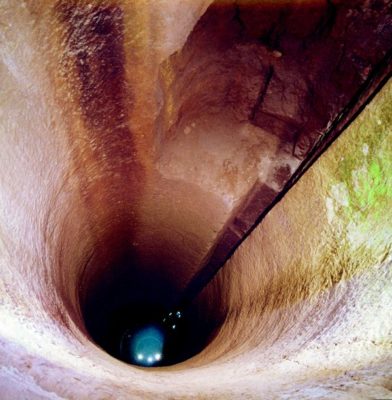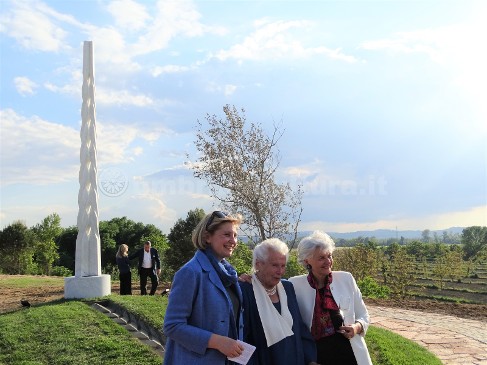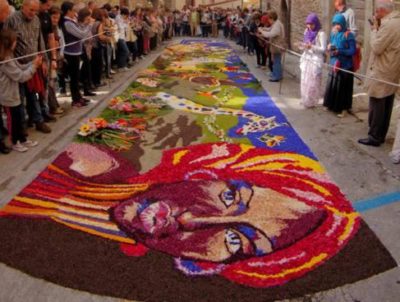Three cave complexes can be visited in Orvieto, very different one from the other: the famous St. Patrick’s Well, the Mill of Santa Chiara and the Pozzo della Cava.
The cliff of Orvieto hides an endless series of caves and tunnels (1204 are the explored ones) excavated along 28 centuries of history; that’s why the Pozzo della Cava is so amazing and particular, here we can admire a series of artificial cavities of very different eras, from the Etruscans to the Renaissance.
It is located in the medieval quarter of Orvieto. As it was impossible to expand the city due to the particular shape of the cliff, the inhabitants were forced to transform and readapt the underground cellars, according to their actual needs; that explains the constant changes and transformations of the cavities.
The water supply in case of siege was the need that caused the creation of several wells, the first to be realized was the Pozzo della Cava.
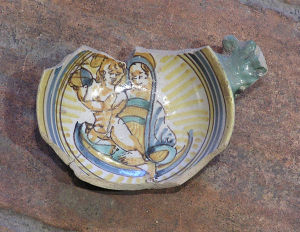
In the first room at the road level (the rooms at this level were used as workshops or stables, the upper floors were used as houses), there is a furnace of ceramics from the Middle Ages. Part of the chimney and the furnace it’s still visible and a series of processing waste of XIV and XV century, typical of the Orvieto production, with some objects used for processing and cooking are on display.
Going down to a lower level and the surprises begin: a “butto” from the medieval era (the butto is a home well made to throw waste) lays less than a meter from an Etruscan tomb (a jump of thousand years in a meter!) but keeping on walking there is a well, a real wonder: 36 meters deep, at the bottom of which you can see the spring water. Rediscovered after a long period of oblivion, it was ordered to be closed in 1600, and was partially filled with waste materials. It was brought to light and emptied in 1996.
But, since nothing there is what it seems, the wells are actually two: the first Etruscan, where it’s still possible to see the “pedarole” (sort of marks on the walls of the well that allowed the descent and lift pointing elbows and feet) and the Renaissance well (much larger and round than the Etruscan that was small and rectangular ) ordered by Pope Clement VII for the supply in case of siege. The Pozzo della Cava inspired the architect Antonio Sangallo for the construction of St. Patrick’s well.
As already mentioned, in 1600 the well was closed, it is said because of public order problems (it was a great place to hide bodies!). A plaque was placed in memory of the well, but not a simple stone of course! The stone keeps its little secret: on the back of the carved inscription, Carolingian style friezes can be seen, probably part of a pulpit of a church.
Keeping on going down to another level, after the “cellaio” on the ground floor, as the typical underground cellar in Orvieto, there’s another room where there were the vats for the first fermentation of the wine and where the filled barrels were rolled down a chute to another room in a lower level. It’s possible to see part of a terracotta pipeline: nothing is what it seems! The ramp where the barrels rolled down was made near a small Etruscan tank.
This cistern collected rainwater, precious stock in the house but, however, it would have stagnated in it becoming useless and, worse, damaging … hence another curiosity: in order to prevent the proliferation of mosquito larvae and to let the water move, tanks (where possible) turned into “farms” of eels! In the dark of the tanks there were albino eels and almost blind, and their meat was very tender and precious.
A curiosity about the “pets” in Orvieto until not so long ago: the owls were bred in captivity, kept hooded during the day, and released in the cellars to hunt mice, and it was also very common to hold a snake in the cellar, always for the same reason.
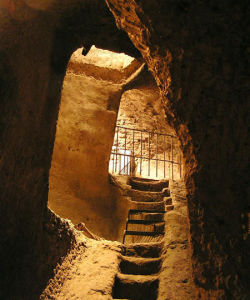
Continuing on, another small “butto” with the vertical walls: the Butto are real treasures to reconstruct the history and daily life of an era. In the Butto used to be buried not only waste, but objects that belonged to the dead by plague: jewelry and everyday objects, too.
In another room there is the base of another small furnace of Renaissance called “muffola”, a furnace for the third fire ceramic technique. The third firing was necessary for the application of the luster. In this room it’s possible to admire a pillar of a medieval tower house living with a part of the excavation of Etruscan origin and with the furnace, in fact, of the Renaissance era.
The last room is the less readable, because of the many transformations: there is an environment surrounded by rocks and a tufa wall. The collapse of the road above necessitates the erection of a wall at the end of 700. This wall was made with the rocks near it, making the previous morphology almost incomprehensible.
The small rooms with some niches opposite in the rock is assumed to be burial caves, imagining the rock outside and not incorporated in a building as it now is. The Etruscan one foot stairs for the access to the tombs can be seen along the wall.
The function of the well “No. 2”, in this room, it is still incomprehensible. Maybe it is an unfinished complex of tanks.
The complex of the Pozzo della Cava, despite being a national monument is privately owned by the Sciarra family. Thanks to the work, passion and dedication of Mr. Terzilio first, and then Marco, we have the good fortune and privilege to see such a large amount of evidence of the city through more than two thousand years of history and life.
Many topics have been touched in such a short text, each of which deserves a study on its own… and it is impossible to be exhaustive here. Marco, my guide, tells about the everyday life in the medieval quarter, the neglect of housing, and the custom of raising fictitious front facades of the houses on the occasion of the papal visits… the particularity of the only Baroque church survived in Orvieto right in front of the entrance of Pozzo della Cava, the ceramics production in Orvieto from XIII and XVI century…
Well, you just have to visit the Pozzo, and be fascinated by all the stories that this rock is able to tell.
by Benedetta Tintillini
Find the Pozzo della Cava on Google Maps:
